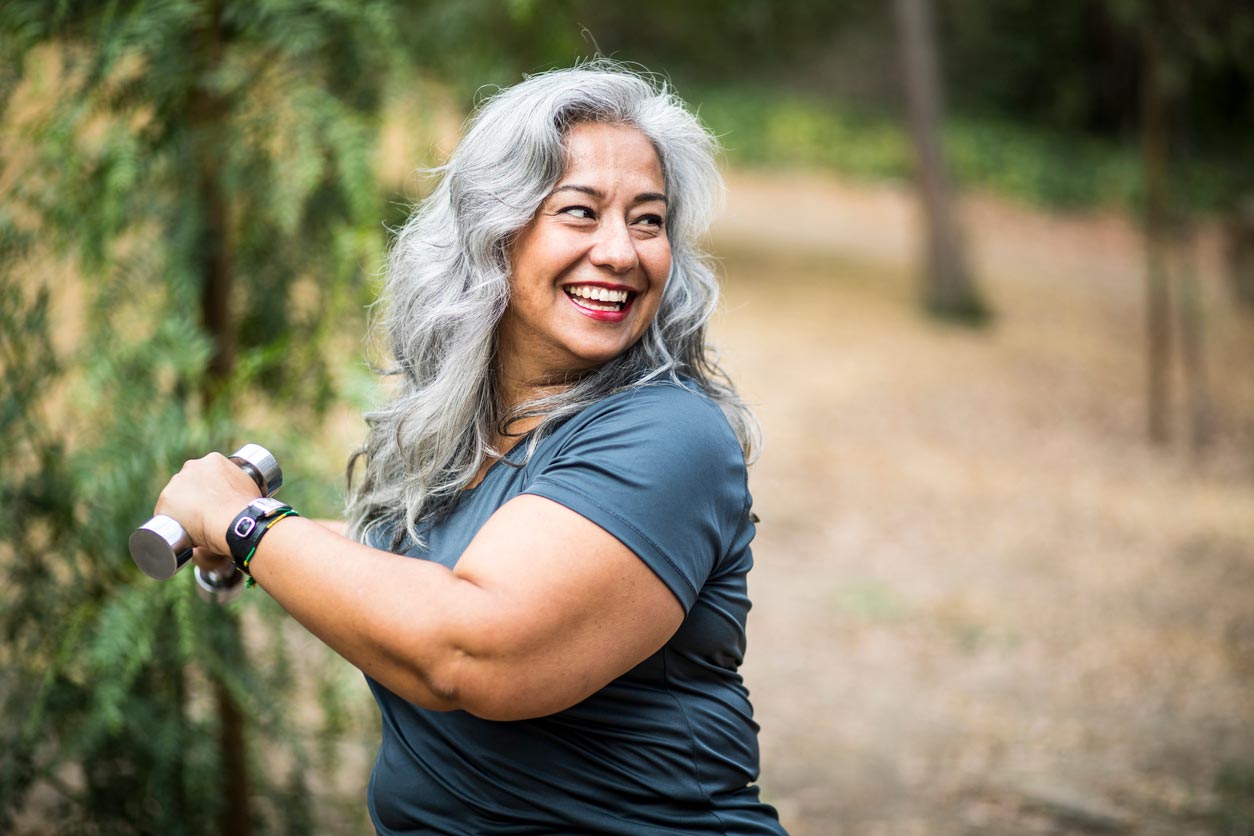Written by Marcella Torres and Derek Tresize • Originally posted on NoMeatAthlete.com
“No pain, no gain.”
That’s what strength or resistance training is all about: big pains, big gains, and giant muscular men straining and grimacing as they lift heavy weights.
Right?
Not so much.
As personal trainers, former competitive bodybuilders, and plant-based nutrition bloggers, who have worked with hundreds of clients, we’ve heard time and time again that resistance training is…
…too complicated.
…too intimidating.
…too “meat-head.”
We’re here to tell you that body- and free-weight training is a lot less complicated than you think. It goes way beyond massive muscles and sweaty grunting in the gym, and it’s not just for the young and lean looking to show off in a bathing suit.
Anyone can do it, and everyone should do it.
Regardless of age, gender, or gym access, everyone can see benefits from resistance training, since consistent training can help you add muscle, lose weight, reduce common aches and pains, and prevent injury. And you can do all that while eating a plant-based diet.
In this post, we’ll give you some background that will motivate you to get started, and provide a simple, beginner-friendly, 15-minute routine that even the busiest individual can find time for and benefit from.
No equipment, gym membership, or tickets to the gun show required.
Resistance Training, Explained
Simply put, resistance training is free- or bodyweight exercises that make you stronger.
But more formally, resistance training is any type of physical training that uses isometric or isotonic exercise to strengthen or develop muscle.
At the risk of getting too science-y, let’s break that down a little bit.
Isometric movements are static; for example, performing a plank in which you are pushing against the floor while your body weight and gravity provide resistance is an isometric exercise.
Isotonic movements include eccentric and concentric muscle contractions. A bicep curl, for example, includes an eccentric contraction as you lower the weight and the muscle lengthens, followed by a concentric contraction as you raise the weight and the muscle shortens.
However, there are some less obvious types of training that can also strengthen and develop muscle. Sprinting, for example, is actually an anaerobic exercise that recruits a ton of muscle fibers — have you seen the legs on an Olympic sprinter?
Athletes use resistance training to get stronger and faster, but this type of weight training does a lot more than just build muscles.
4 Reasons Why Everyone Can Benefit from Resistance Training
No matter if you’re trying to gain muscle, lose fat, run injury-free, or simply maintain a healthy lifestyle, resistance training can help you enjoy the activities you love.
Here’s why:
1. The more muscle you have, the more calories you burn around the clock, even while you sleep.
Lean tissue, including skeletal muscle developed during exercise, is far more energetically expensive to maintain than fat, so the more muscle you have, the more calories you burn.
This boost in metabolic rate makes resistance training the perfect complement to endurance training (cardio), which is sometimes associated with a slowing of metabolic rate.
2. Resistance training combats the muscle loss that occurs with aging and keeps you from getting frail as you age.
Skeletal muscle atrophy increases sharply for sedentary individuals over 50, leading to increased injury risk and even chronic disease risk. This decline in muscle mass of around 0.18 kg per year can be completely reversed with resistance training.
In one meta-analysis of over 1,300 older individuals in 49 studies, an average increase in lean mass was over 1 kg in just 20 weeks of resistance training.
That’s a pretty big net gain even with age-related muscle loss!
3. Resistance training is the single best tool for improving and maintaining bone density.
A review in Medicine & Science in Sports & Exercise found that resistance training increased bone density and improved other risk factors better than pharmacological and nutritional approaches, and controlled trials consistently show the same.
We’ve found this to be true across the board from our own experience with clients, even older clients.
4. Resistance training will improve the strength and stability of all the joints in your body.
Anyone can get injured, even if you’re just walking down the street — and athletes have the added risk of injury while training.
Resistance training is a layer of defense against injury.
Stronger muscles will better support your joints, which will then be less likely to exceed their normal range of motion. Stronger bones will provide your body with better support and will better resist breaking upon impact. Add to all this that your stronger legs and core will be more stable and sure as you move through the world, preventing stumbles, missteps, and falls, and it’s easy to see why resistance training can do a lot to keep you pain-free.
It’s easy to see how resistance training can make you more healthy and help you avoid injury, but it’s not just about reps — a lot of your gains will be made in the kitchen.
Why a Plant-based Diet Actually Improves Results
By now, most of us have heard the “skinny vegetarian” jokes once or twice, and we’re pretty familiar with the old misconception that eating only plants will handicap athletic performance in general and strength training, in particular.
Thankfully, this outdated idea is fading away as more and more professional athletes make headlines by switching to plant-based diets to maximize performance and recovery and remain competitive as they age.
Getting all your daily nutritional needs from exclusively plant sources will not only provide you with plenty of protein, but will also give you a mother lode of beneficial nutrients like complex carbohydrates, fiber, vitamins, minerals, and antioxidants. This nutrient infusion will boost your recovery and get you back in the gym faster with more energy for your workout.
If you still need convincing, look no further than mother nature. Have you ever seen a stallion, bull, or gorilla? Notice anything about them?
Not only do all three have amazing levels of natural muscularity, but all three eat only plants!
What About Protein?
Right or wrong, protein is a big concern for athletes of any type, but we can set two things straight right now:
1. If you eat enough whole plant food, you will get enough protein.
One thing we have heard consistently over the years is, “I tried to be vegan, but I couldn’t get enough protein as a runner/weight-lifter/martial artist, etc.”
Usually, if you dig a little deeper, you’ll find this person transitioned to a plant-based diet from an animal-food-centered diet and continued to eat the same volume of food. Plant foods, however, are more nutrient-dense but far less calorie dense and, in general, you need to eat more of them than of nutritionally impoverished but calorie-heavy animal foods.
This is where taking a few days to track what you’re eating can be a big help if you are already physically active and experiencing unwelcome weight loss or having trouble retaining or gaining muscle.
2. You do not need sports supplements of any kind to gain muscle or strength or to lose body fat.
By training consistently and consuming high-quality nutrition, you will achieve your goals. You may be able to get a slight extra edge from supplementing — which may be significant for a dedicated athlete who has already pulled out all of the other stops. For most, however, it’s relatively insignificant.
If you feel like you would benefit from sports supplements, make sure you choose a healthy and safe product. There are several plant-based protein powders that are safe and effective — as is plain and simple creatine monohydrate (a molecule that provides rapid energy to the muscle cells during intense activity).
With the protein myth out of the way, let’s talk about the workouts.
A Simple Strength Routine You Can Do At Home
Now we know resistance training is good for us, and that we can still build lots of muscle while thriving on a plant-based diet.
But how do you get started with a routine?
In the beginning, we recommend to keep it short and simple. Like we said, resistance training isn’t just for those looking to bulk up, so starting with a routine that builds strength and defines muscles — without ruining your busy schedule or forcing you to go to the gym — is where most people should begin.
We’ve put together a beginner program that is designed to both build strength and muscle and combat common problems like shoulder and hip tightness.
These four, easy-to-master exercises can be completed in just 15 minutes. And in that short time, you will work most of the muscle groups of the body, and all the major groups. These exercises will also address many common muscular imbalances and weak points.
We recommend you perform this routine consistently for 4-6 weeks and then progress to a more comprehensive total-body routine when you’re ready.
The 15-Minute Strength Workout
Complete this workout 3-4 times per week.
- Body Weight, Dumbbell, or Barbell Squat: 2 sets of 15 repetitions (30 total squats) Rest 30-60 seconds between sets and between exercises
- Glute Bridges, or Hip Thrusts: 2 sets of 15 repetitions (30 total glute bridges) Rest 30-60 seconds between sets and between exercises
- Bear Plank: 4 sets of 15 seconds (4 total bear planks) Rest 30-60 seconds between sets and between exercises
- Side Plank w/ External Shoulder Rotation: 2 sets of 15 repetitions per side (2 side planks per side, 30 total shoulder rotations) Rest 30-60 seconds between sets and between exercises
Click here for a free printable version of this workout, plus detailed explanations of each exercise and variation.
Note: Always consult a physician before beginning a new health or fitness program, especially if you’re very overweight, elderly, or have an existing injury.
After just a couple of workouts, you may notice more space between your shoulders and your ears and a slight easing of tension in your lower back. Stick with the program for a minimum of four weeks, and you will find that this one 15-minute habit can transform your body while helping you decompress from the stresses of daily life. Once you experience the benefits of regular resistance training, you’ll be hooked!
Just 15 Minutes Can Make All the Difference
Resistance training is like a secret weapon to burning fat and preventing injuries from athletic training, age-related ailments, and even day-to-day living. There are countless benefits and virtually no drawbacks.
So what are you waiting for?
Start small. Start simple.
Start at home with just 15 minutes a few times per week. And in just a few weeks, you’ll begin seeing real, lasting results.
About the Authors: Marcella Torres and Derek Tresize have been competitive bodybuilders, fitness, and nutrition bloggers at Vegan Muscle and Fitness, and owners of Richmond, Virginia, plant-based personal training studio, Root Force Personal Training, since 2009. Between them, they have three degrees in subjects from biology to mathematics (and a fourth in the works), various personal training certifications, two vegan kids, and a vegan dog named Joe.
Tell us in the comments:
- Have you ever done resistance training?
- What are your favorite ways to build strength?
Featured image: iStock.com/gradyreese






